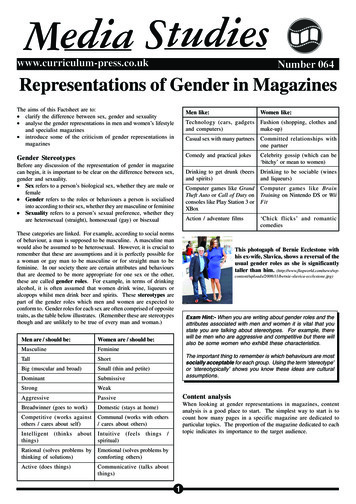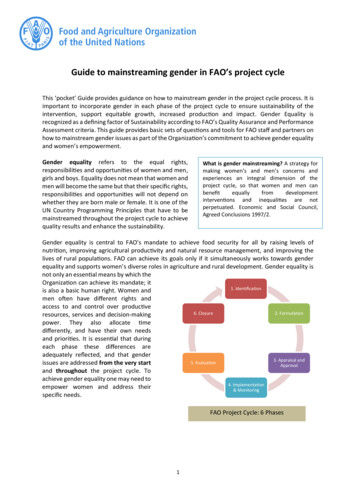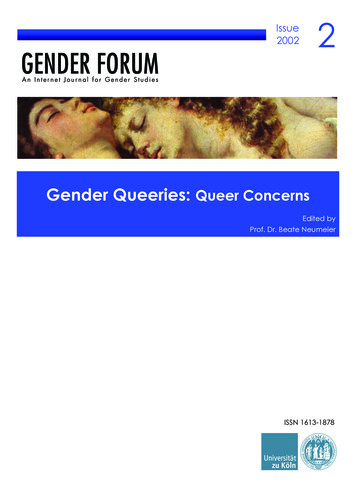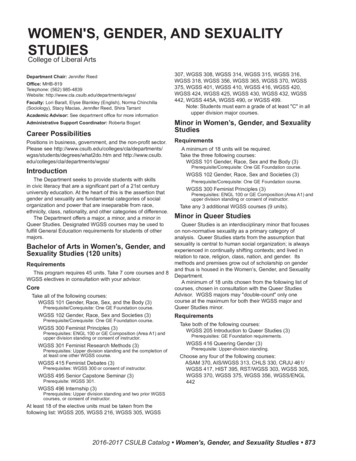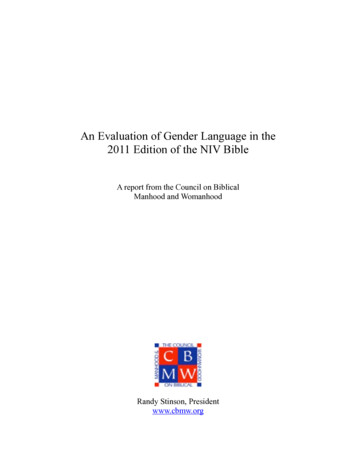
Transcription
An Evaluation of Gender Language in the2011 Edition of the NIV BibleA report from the Council on BiblicalManhood and WomanhoodRandy Stinson, Presidentwww.cbmw.org
The Council on Biblical Manhood and Womanhood (CBMW),2825 Lexington Road, Box 926, Louisville, KY 40280.www.cbmw.org. (502) 897-4065.
1
An Evaluation of Gender Language in the 2011 Edition of the NIV BibleThe Council on Biblical Manhood and WomanhoodIntroductionAccording to the Christian Booksellers Association, the NIV is the best-selling Biblein English—ahead of the King James Version, the New King James Version, the New Livingtranslation, the English Standard Version, the New American Standard, and several others.1But now Zondervan, the publisher of the NIV, has issued a new edition, the 2011 NIV.This edition will replace the current NIV (the 1984 edition). What is this new edition like?The last two attempts at revising the NIV were met with a great deal of controversydue to their use of a gender-neutral philosophy of translation.2 The gender-neutral approach ofthe TNIV (Today’s New International Version) in 2002 and 2005 became such a lightning-rodthat the version never caught on with American evangelicals and has now been discontinued.The TNIV provoked a lively discussion among evangelical scholars and Bible readersabout translation philosophy in general and about gender-neutral approaches in particular. In fact,the debate actually preceded the appearance of the TNIV because of rumors in the evangelicalworld that the NIV was going “gender-neutral.” That debate began in 1997 and extended throughthe mid-2000s. Many of the contested issues in that discussion remain unresolved.3It is no surprise, therefore, that many evangelicals have been anticipating the release ofthe 2011 NIV. Readers want to see how this latest revision has resolved (or not resolved) pointsof contention about gender language that are left over from these previous discussions.1TheCBA’s rankings are available online at http://www.cbaonline.org/nm/documents/BSLs /Bible Translations.pdf.2Thefirst attempt was the New International Version - Inclusive Language Edition (NIVI) in 1996(released only in the UK), and the second was Today’s New International Version (TNIV) in 2005.3SeeMark L. Strauss, Distorting Scripture?: The Challenge of Bible Translation & Gender Accuracy(Downers Grove, IL: InterVarsity, 1998).; Glen G. Scorgie, Mark L. Strauss, and Steven M. Voth, eds., TheChallenge of Bible Translation (Grand Rapids: Zondervan, 2003); Vern S. Poythress and WA Grudem, The GenderNeutral Bible Controversy: Muting the Masculinity of God’s Words (Nashville, TN: Broadman & Holman, 2000); D.A. Carson, The Inclusive-Language Debate: A Plea for Realism (Grand Rapids: Baker, 1998); Vern S. Poythress andWA Grudem, The TNIV and the Gender-Neutral Bible Controversy (Nashville, TN: Broadman & Holman, 2004);Wayne Grudem and Jerry Thacker, Why Is My Choice of a Bible Translation So Important? (Louisville, KY: Councilon Biblical Manhood and Womanhood, 2005).2
Does the 2011 NIV deserve the same prominence among evangelicals that the 1984NIV has enjoyed for so many years? Or will 2011 NIV fall into disuse and go the way of theTNIV?Readers should realize, first, that the 2011 NIV is not a revision based on the old NIVof 1984, but is a revision based on the now-defunct TNIV of 2005. So there is an obviousquestion that needs answering. Have the weaknesses of the TNIV been sufficiently overcome inthe 2011 NIV?The following analysis explains both the commendable changes in the new NIV andthe areas where we still have cause for concern.A. Many Welcome Improvements in the 2011 NIV1. The ProcessFirst, a word about the translation process: We are grateful for the openness and honestyexpressed by Zondervan and the NIV’s Committee on Bible Translation (CBT) during the earlystages of this revision. Several private conversations were held long prior to the finalization ofthe work of the CBT (indeed, the CBT humbly solicited input from a number of sources), and theleadership at Zondervan was very forthright about their intentions and plan. Particularly to becommended are recent Zondervan President Moe Girkins and CBT Chairman Doug Moo. Theirintegrity from the very beginning of this process has set the stage for a respectful discussion ofsubstance of this new translation.2. Many Noteworthy ImprovementsWith regard to the actual words in the 2011 NIV, the translators have made numerousimprovements that are worthy of note.4For instance, in most cases the key Pauline term sarx has been changed from “sinfulnature” to the more literal and precise term “flesh” in the 2011 NIV (for example, Rom. 8:4). InRomans 1:17 and related texts, “righteousness from God” becomes “righteousness of God.” Inother verses, “observing the law” becomes “works of law” (see Rom. 3:20, 28). All three of thesechanges now leave open important interpretive options and represent a significant improvementover renderings in the 1984 NIV that closed those options.3. Improvements in Gender LanguageRegarding gender language, the new NIV also makes numerous commendableimprovements. For example, in 164 passages, “man” and “mankind” have replaced a gender-4TheCommittee on Bible Translation summarizes many improvements in a report released online inlate 2010: “Updating the New International Version of the Bible: Notes from the Committee on BibleTranslation” (The Committee on Bible Translation, August 2010), ion-Notes-Final1.pdf.3
neutral equivalent such as “humanity” (as in Gen. 1:27, which now says, “God created mankindin his own image,” retaining the male-nuanced meaning of Hebrew ’adam).5Similar welcome changes have been made in hundreds of verses where “brother,”“father,” “son,” and “he/him/his” have been restored, replacing the gender-neutral alternativesthat were used in the TNIV. In total, we have counted 933 places where gender-neutraltranslations in the TNIV have been changed in the 2011 NIV, and in most cases they have beenreplaced with more accurate, gender-specific translations. 6We are thankful for this significant improvement in nearly a thousand places in the2011 NIV, and we recognize that the NIV’s Committee on Bible Translation expended a largeamount of effort and scholarly discussion to make these changes. In fact, many of theseimprovements were made at verses that were highlighted in previous criticisms of the TNIV byCBMW and others. And there are numerous other improvements as well that we cannot mentionhere.B. Statistical Summary: 75% of Inaccurate Gender Language Translations from the TNIVAre Retained in the 2011 NIVIn spite of these numerous improvements, however, there are still significant unresolvedissues related to gender language.The rest of this report considers (1) an overall summary of the changes, then (2) someverses relevant to women’s roles in the church (a concern of the Council on Biblical Manhoodand Womanhood since our founding), and finally (3) specific examples of changes in genderlanguage from the 1984 NIV to the 2011 NIV.Vern Poythress and Wayne Grudem were instrumental in cataloguing problematicrenderings in the TNIV New Testament after it first appeared in 2002.7 Then in a CBMW report,5For a full list of these and other changes listed by category and verse, see www.cbmw.org.6 See previous note for a full list of such revisions, including an annotation where each verse has beencorrected from the TNIV. However, it should be noted that this total of 933 is probably a bit high, since it includesall the instances where the objectionable gender language of the TNIV has been revised, but in some of thosepassages one gender-neutral term has just been replaced with another, and some inaccuracy remains.7The TNIV New Testament appeared in 2002. In response, Vern Poythress and Wayne Grudempublished in 2004 The TNIV and The Gender-Neutral Bible Controversy in which they cataloged 900 NewTestament examples of gender-related “translation inaccuracies” (p. 73). The TNIV Old Testament appeared in 2005along with another revision of the TNIV New Testament.4
Wayne Grudem and Jerry Thacker, catalogued some 3,686 “inaccurate translations in the TNIV”that related to gender language when the entire TNIV Bible first appeared in 2005.8In preparation for this present report, researchers at the Council on Biblical Manhoodand Womanhood office surveyed all of these 3,686 problems in the TNIV to see how they wererendered in the 2011 NIV.9 We found that although the 2011 NIV corrected many of its mostcontroversial renderings of gender language from the TNIV, the majority (75%) of the problemsidentified by Poythress and Grudem still remain. In numerous cases the 2011 NIV follows theTNIV and unnecessarily removes male-oriented terminology that was present in the 1984 NIV—especially the use of generic masculine forms of expression.The charts below show a numerical summary of our findings. The charts show howmany corrections were made from the 2005 TNIV to 2011 NIV.10Table 1 – Summary of Revisions of 3699 Inaccurate Gender LanguageTranslations from TNIV to NIV 2011TestamentsOTNTTotalSame asTNIV21945722766Revised fromTNIV597336933%Same %Revised79%21%63%37%75%25%As this chart indicates, of the 3,699 “inaccuracies” from the TNIV that we confirmedfrom Grudem and Thacker, we found that three fourths of them (75%) stayed exactly as they8WayneGrudem and Jerry Thacker, Why Is My Choice of a Bible Translation So Important?(Louisville, KY: Council on Biblical Manhood and Womanhood, 2005), p. 33. Grudem and Thacker’s appendixcatalogued some 3,686 “inaccurate translations in the TNIV” in both Old and New Testaments. Because the 2005TNIV included some revisions to the 2002 TNIV New Testament, Grudem and Thacker identified 10 additionalproblems in the TNIV New Testament and that brought the total number of “inaccuracies” for the NT up to 910(ibid., 81-96), along with 2,776 in the Old Testament.9Using Grudem and Thacker’s list, our researchers identified added fifteen new problem passages anddeleted two, for a net increase in the base list of thirteen, giving a total of 3,699 problematic renderings in the 2005TNIV.10Wewere greatly assisted in this research by an online tool that tracks how the 2011 NIV compares tothe NIV 1984 and the TNIV. The creator of this resource is Robert Slowley, a senior software engineer at theEuropean Bioinformatics Institute in Cambridge, U.K. The data from this comparison is available in a table at thefollowing website: http://www.slowley.com/niv2011 comparison.5
were in the TNIV.11 That means that whatever improvements have appeared, the vast majority ofthe “inaccuracies” identified by Grudem and Thacker persist in the 2011 NIV.A close inspection of the 25% that were revised shows that the 2011 NIV has backedaway from some of the most heavily criticized gender-neutral renderings of the TNIV, and forthat we are thankful. Nevertheless, the modifications were incomplete. Here is a breakdown bycategory for Old Testament and New Testament:11 This chart also includes a handful of changes to the terms “the Jews” and “saints,” since those werepart of the earlier study, but the vast majority of the changes were to gender language, and that is our primaryconcern in this analysis.6
Table 2 – Summary of Old Testament Revisions from TNIV to 2011 NIVCategoryA. Changes Made from Singular to Plural (and aFew Related Changes) to Avoid the Use of “He/Him/His”B. Changes Made to Avoid the Word “Father”C. Changes to Avoid the Word “Brother”D. Changes to Avoid the Word “Man”E. Changes to Avoid the Word “Son”F. Changes Made to Avoid the Word “Women”TotalSame as 44%0%21%Table 3 – Summary of New Testament Revisions from TNIV to 2011 NIVCategoryA. Changes from Singular to Plural to Avoid theUse of “He/Him/His”B. Changes to Avoid the Word “Father” andRelated WordsC. Changes to Avoid the Word “Brother” (Or toAdd the Word “Sister”)D. Changes to Avoid the Word “Man”E. Changes to Avoid the Word “Son”F. Changes to Avoid the Phrase “The Jews”G. Changes that Lose the Nuance of Holiness in“Saints”H. Other ChangesTotalSame as %7572433664%63%36%37%Detailed lists of these changes can be found at www.cbmw.org.The following section gives specific examples of these remaining translation difficulties.7
C. Examples of specific changes from the 1984 NIV to the 2011 NIVThe main question facing current NIV readers is not how much the new NIV is like theTNIV (see above), but rather, How much has changed from the 1984 NIV that I am currentlyusing? Therefore the following section examines changes from the 1984 NIV to the new 2011NIV.1. The 2011 NIV adopts feminist-leaning translations in several key verses dealingwith women’s role in the churchWe expect that evangelical feminists who claim that women can be pastors and elderswill eagerly adopt this 2011 NIV because it tilts the scales in favor of their view at several keyverses. This is especially true because the new NIV changes the primary verse in the debate overwomen’s roles in the church.1984 NIV1 Timothy 2:12 I do not permit a woman to teach or to have authority over aman; she must be silent.2011 NIV1 Timothy 2:12 I do not permit a woman to teach or to assume authority over aman; she must be quiet. (same as TNIV, but with modified footnotes)Evangelical feminists will love this translation because in one stroke it removes theBible’s main barrier to women pastors and elders. As soon as a church adopts the 2011 NIV, thedebate over women’s roles in that church will be over, because women pastors and elders canjust say, “I’m not assuming authority on my own initiative; it was given to me by the otherpastors and elders.” Therefore any woman could be a pastor or elder so long as she does not takeit upon herself to “assume authority.”The NIV’s translation committee says that the translation “assume authority” is “aparticularly nice English rendering because it leaves the question open.” In other words, “assumeauthority” could be understood in two different ways: a negative way (meaning “wrongly assumeauthority on one’s own initiative”) or a positive way (meaning “begin to use authority in arightful way”). But in saying this the NIV translators fail to understand the full force of whatthey have done: They have given legitimacy to a feminist interpretation that did not havelegitimacy from any other modern English translation (except the discontinued TNIV).Whether the verb is understood in a negative or positive way, the focus of the verse isnow on prohibiting a self-initiated action, taking it on oneself to “assume authority” over men.And so feminists will now quickly say that they are not assuming authority on their owninitiative – they are just “accepting” it because others entrusted it to them. In any local churchthat uses this new NIV, no one will be able to answer their argument from this Bible.This verse alone in the 2011 NIV gives evangelical feminists the most important advancefor their cause in the last thirty years. But the translation is simply incorrect, as many writers8
have demonstrated in extensive scholarly discussion elsewhere,12 and as all other modernEnglish translations agree: Even the gender-neutral NRSV translates authenteō “have authority”here —along with the NIV, NLT, RSV, Holman CSB, and NKJV, while the NASB, NET Bible,and ESV similarly translate it as “exercise authority.” Thus, the NIV is out on a limb here overagainst the other main modern English translations. And it is out on a limb precisely because ofits attempt to be “neutral” on a passage that even the liberal translators of the NRSV have notattempted to make more amenable to an egalitarian interpretation. The verb authenteō heremeans “exercise authority” or “have authority,” not “assume authority.”This mistaken NIV translation of 1 Timothy 2:12 we find to be particularly unfortunate,because it might well constitute the single reason why churches decide no longer to use the NIVBible, since apparently it will now be available only in this new 2011 edition and the 1984 NIVwill be discontinued.Several other verses have also been changed from the 1984 NIV, and all the changes havemoved in the same feminist direction.1984 NIVRomans 16:7 Greet Andronicus and Junias, my relatives who have been in prisonwith me. They are outstanding among the apostles, and they were in Christ before I was.2011 NIVRomans 16:7 Greet Andronicus and Junia, my fellow Jews who have been inprison with me. They are outstanding among the apostles, and they were in Christ beforeI was. (same as TNIV, except for footnote)This verse changes “Junias” (a man’s name) to “Junia” (a woman’s name; the Greekspelling could refer to either a man or a woman), and now says that “Andronicus and Junia” are“outstanding among the apostles,” thus making the woman “Junia” an apostle. This is a highlydisputed verse, but the NIV now clearly gives more weight to the feminist argument that saysthere was at least one woman apostle, and if a woman could be an apostle (like Paul or Peter,presumably), surely women can be pastors and elders as well.Some other recent evangelical translations also translate this name as “Junia” (a woman),but at least three conservative translations do not then make Junia an apostle. Based on what weat CBMW think to be a better understanding of the Greek phrase episēmoi en tois apostolois,1312 See Wayne Grudem, Evangelical Feminism and Biblical Truth (Sisters, OR: Multnomah, 2004), pp.304-318, especially the summaries of the studies by H. Scott Baldwin, “A Difficult Word: Authenteō in 1 Timothy2:12,” in Women in the Church: A Fresh Analysis of 1 Timothy 2:9–15, ed. Andreas Köstenberger, ThomasSchreiner, and H. Scott Baldwin (Grand Rapids: Baker Book House, 1995), 65–80 and 269–305, and Andreas J.Köstenberger, “A Complex Sentence Structure in 1 Timothy 2:12,” in Women in the Church, 81–103. Baldwin’sarticle provides a range of possible meanings for authenteō, and Köstenberger’s article argues from syntax to showthat the verb cannot have a negative sense in this sentence structure.13 See discussion in Grudem, Evangelical Feminism and Biblical Truth, pp. 224-225, with reference to agroundbreaking semantic study by M. H. Burer and D. B. Wallace.9
both the ESV and the NET Bible say that Andronicus and Junia are “well known to the apostles,”and the Holman CSB says they are “noteworthy in the eyes of the apostles.” Thus, the apostlesrecognized Andronicus and Junia, but they were not themselves apostles. (The new NIV alsogives a similar reading to this as an alternative in a footnote.) We recognize that there are otherexplanations for this contested verse, but it still should be noted that, in contrast to three otherrecent evangelical translations, the new NIV adopts the translation strongly favored by feminists,apparently making Junia an apostle.Although the Greek term apostolos that is used here can sometimes have the weakersense “messenger” (see John 13:16; Phil. 2:25), the new NIV does not give that as an alternativetranslation at Romans 16:7. Moreover, the English word “apostle” everywhere else in the newNIV refers to the absolutely authoritative messengers of Christ like Peter and Paul, and thereforereaders of the new NIV will be led to conclude that women could be apostles of such stature –just like Junia.1984 NIV1 Corinthians 14:33-34 For God is not a God of disorder but of peace.As in all the congregations of the saints, women should remain silent in the churches.They are not allowed to speak, but must be in submission, as the Law says.2011 NIV1 Corinthians 14:33-34 For God is not a God of disorder but of peace--as in allthe congregations of the Lord's people.Women should remain silent in the churches. They are not allowed to speak, but must bein submission, as the law says. (same as TNIV)The question here is where to divide the paragraph and where to put the phrase, “as in allthe congregations of the saints.” The old NIV put the phrase with what follows, so Paul said, “Asin all the congregations of the saints, women should remain silent in the churches.” There is agood reason for this: the Greek word ekklēsia (“church, congregation”) is repeated in bothphrases, tying them together, and a statement that something is done “in all the congregations” isan appropriate way for Paul to give weight to what he says about women speaking in church.What does Paul mean by “women should remain silent”? Many interpreters take this tomean that women should be “silent” when spoken prophecies were being judged (a governingfunction for the whole church). But whatever kind of silence Paul meant, the phrase “As in allthe congregations of the saints” showed that Paul was not just solving some local problem atCorinth but was reminding them about the established practice of all the churches. “All thechurches” had some kind of restrictions on some kinds of speech by women in the assembledcongregation.But the 2011 NIV now disconnects the phrase “as in all the congregations of the Lord’speople” from the statement, “women should remain silent in the churches” (1 Cor. 14:33-34).10
They put that phrase with the previous sentence: “For God is not a God of disorder but of peace-as in all the congregations of the Lord's people” (1 Cor. 14:33). Now Paul’s statement that“Women should remain silent in the churches” (1 Cor. 14:34) starts a new paragraph, and thefeminist argument that Paul was only addressing a local problem at Corinth (not a problem thatapplies to churches today) has gained new force. Once again the new NIV has been modified in away that favors a common feminist interpretation.Now it must be said that at several of these verses the new NIV does give an alternative,more conservative reading in a footnote, and we appreciate that. But what people read in atranslation are the words in the Bible text itself, far more than the footnotes. And the 2011 NIVhas shifted some key verses in a gender-neutral way that supports women apostles and womenelders.The Council on Biblical Manhood and Womanhood cannot endorse a Bible that makesthese changes in an evangelical feminist direction, particularly in its incorrect translation of1Timothy 2:12.1a. Making Phoebe a deacon in Romans 16:1 will be of concern to churches wheremale deacons have a governing role over the churchIn a somewhat related verse, one other change should be noted that will be of concern tosome churches:1984 NIVRomans 16:1 I commend to you our sister Phoebe, a servant of the church inCenchrea.2011 NIVRomans 16:1 I commend to you our sister Phoebe, a deacon [footnote: orservant] of the church in Cenchreae. (same as TNIV)This verse changes Phoebe from a “servant” to a “deacon” of the church at Cenchrea, andthereby it endorses women as deacons. Both translations are possible meanings for the Greekword diakonos, and the decision must be made from the larger New Testament context. (In theentire New Testament, the TNIV translates diakonos as “deacon” only 4 times out of 29occurrences: here in Rom. 16:1 and in three verses where no individual is named but a churchoffice is clearly in view: Phil. 1:1; 1 Tim. 3:8, and 12.)At this point the 2011 NIV adds two footnotes, one that helpfully says, “Or servant,” andanother that says, “The word deacon refers here to a Christian designated to serve with theoverseers/elders of the church in a variety of says; similarly in Phil. 1:1 and 1 Tim. 3:8, 12.” Thesecond note clearly ties the usage here to the office of “deacon” in Philippians and 1 Timothy.11
CBMW has not taken a position on whether women can be deacons,14 and so ourcomment here is more of an observation than an objection. For churches and denominations thatdo not have women deacons, the new NIV will prove difficult. These churches hold that“deacon” is a governing office in the church and that 1 Tim. 3:12 requires deacons to be “thehusband of one wife.” But if such churches use the 2011 NIV, the debate about women asdeacons will shift: Phoebe is now named as a deacon in Rom. 16:1; therefore, it seems, womenshould be deacons today. This will be of concern to a number of churches.2. The 2011 NIV incorrectly changes “father” to “parent” or something else1984 NIVProverbs 15:5 A fool spurns his father's discipline, but whoever heeds correctionshows prudence.2011 NIVProverbs 15:5 A fool spurns a parent's discipline, but whoever heeds correctionshows prudence. (same as TNIV)But the Hebrew text has ’ab, which means “father,” not “parent.” Fifteen other verses inthe 2011 NIV make a similar change. Why seek to eliminate “father” when that is the precisemeaning of the Hebrew text?There are no cases in the Old Testament where the singular Hebrew word ’ab means"parent" rather than "father." Hebrew lexicons define this word in singular as "father," not as"parent" (see Brown-Driver-Briggs, Hebrew and English Lexicon of the Old Testament, p. 3;also Koehler-Baumgartner, Hebrew and Aramaic Lexicon of the Old Testament, pp. 1-2). But thenew NIV translators in verses like this were unwilling to translate the word with the clear, simpleEnglish equivalent "father," apparently because in today's culture it is unpopular to use anexample of an individual father to teach a general truth that applies to all parents. Even whenthat is what the Hebrew text does, the 2011 NIV is often unwilling to allow English readers todayto see it. “Father” seems to be a "taboo" word that must be avoided in contexts that teach a moregeneral truth.Similar changes in other verses diminish the role of the father in Israelite society. Forexample,1984 NIV1 Samuel 18:2 From that day Saul kept David with him and did not let him returnto his father's house.14 For example, both views are represented in John Piper and Wayne Grudem, Recovering BiblicalManhood and Womanhood (Crossway, 1991).12
2011 NIV1 Samuel 18:2 From that day Saul kept David with him and did not let him returnhome to his family. (same as TNIV)Although the Hebrew text in such verses speaks several times of a "father's house" or"father's family" and uses the ordinary Hebrew word for "father" (’ab), the new NIV eliminatesthe word "father" and substitutes "family" or some other expression. The new expressionsremove any suggestion of a father's leadership role in the family. These new NIV verses are nottranslated accurately, but they are consistent with the new NIV’s practice of removing maleoriented details of meaning from the text of the Bible.3. The 2011 NIV incorrectly changes “forefather” to “ancestor”1984 NIVJoshua 19:47 They settled in Leshem and named it Dan after their forefather.2011 NIVJoshua 19:47 They settled in Leshem and named it Dan after their ancestor.(same as TNIV)The Hebrew text has ’ab, the ordinary word for “father,” and here the translation“forefather” is appropriate for such a reference to a male ancestor from earlier generations. Butthe new NIV’s word “ancestor” eliminates the male component of meaning that would have beenevident to every Hebrew reader because this was the common word meaning “father.” Thischange occurs 313 times in the 2011 NIV. Why does the new NIV seek to eliminate malemeaning that is present in the Hebrew or Greek text?4. The 2011 NIV incorrectly changes “mighty men” to “mighty warriors”1984 NIV2 Samuel 23:8: These are the names of David's mighty men: Josheb-Basshebeth,a Tahkemonite, was chief of the Three; he raised his spear against eight hundred men,whom he killed in one encounter.2011 NIV:These are the names of David's mighty warriors: Josheb-Basshebeth, aTahkemonite, was chief of the Three; he raised his spear against eight hundred men,whom he killed in one encounter. (same as TNIV)The Hebrew noun gibbor means “strong, valiant man” (Brown-Driver-Briggs, Hebrewand English Lexicon of the Old Testament, p. 150; the word is related to the adjective gibborwhich means “strong, mighty”). At least since the King James Version of the Bible (1611), theterm gibbor has been translated as “mighty men” when referring to King David’s elite circle of“thirty mighty men” and then his even greater “three mighty men” (especially in 2 Sam. 23 and 1Chron. 11).13
The NIV had translated this word correctly as “mighty men” in these contexts, indicatingboth the strength of these men and their manhood. Surely in that ancient culture there were nowomen among David’s thirty “mighty men.” It is hard to understand then why the 2011 NIVchanges and calls them “mighty warriors” (here and 20 other times). But it is consistent with thenew NIV’s pattern of removing many male-oriented words from the text.In an age when books are being written about the way men are staying away from church,it is ironic that the NIV removes David’s “mighty men.” What man who reads about David’smighty men has not wanted to imitate their courage, their strength against evil, their faithfulnessto God in serving their king? But in the new NIV they are no longer “men.”14
5. The 2011 NIV incorrectly changes “son” to “child”1984 NIVProverbs 13:24 He who spares the rod hates his son, but he who loves him iscareful to discipline him.2011 NIVProverbs 13:24 Whoever spares the rod hates their children, but the one wholoves their children is careful to discipline them.The Hebrew word here is ben (singular), and it means “son,” not “child” and certainly not“children.” The pronoun connected to “son” is masculine singular and means “his” not “their.”The Bible often teaches by giving a specific, concrete example (such as a specific father who isdisciplining a specific son) and then expecting the readers to apply this vivid example moregenerally as appropriate. But in 33 places the new NIV finds such a specific masculine exampleof a “son” objectionable and changes
the TNIV (Today’s New International Version) in 2002 and 2005 became such a lightning-rod that the version never caught on with American evangelicals and has now been discontinued. The TNIV provoked a lively discussion among evangelical scholars and Bible readersFile Size: 286KB


